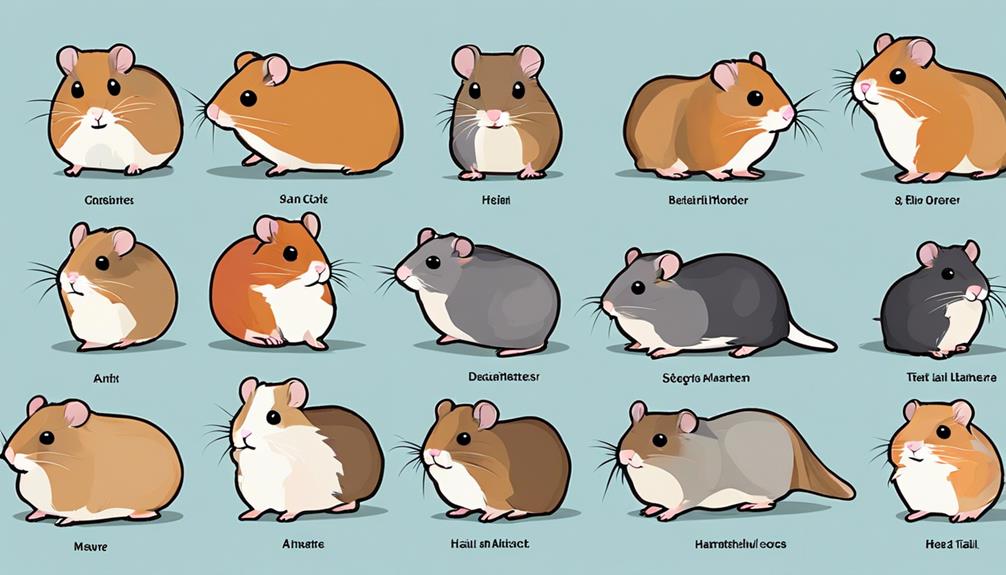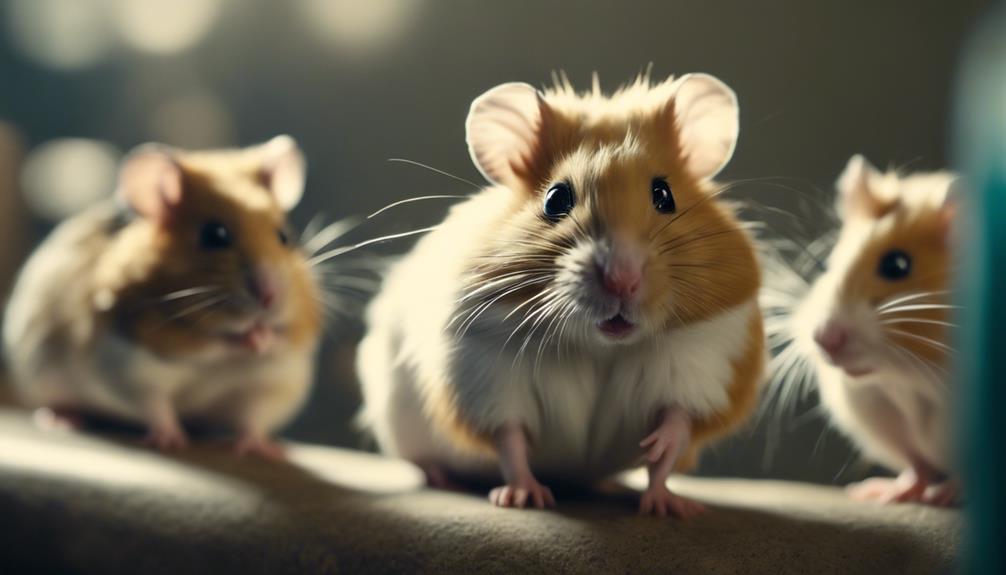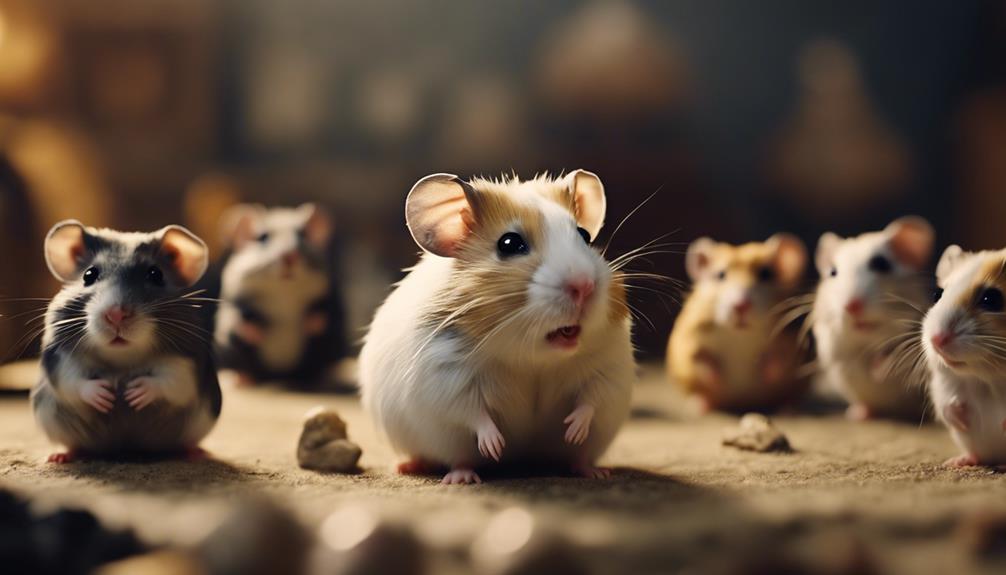Why Do Some Hamster Breeds Have Longer Tails?

The length of a hamster's tail is determined by genetics and environmental factors. Longer tails in certain breeds may have evolutionary advantages, but the exact significance remains unclear.
Behavioral functions, adaptive advantages, and selective breeding practices all contribute to the variation in tail length among hamster breeds.
Genetic Influences on Tail Length
Genes play a crucial role in determining the length of a hamster's tail, influencing the variations observed across different breeds. Inheritance patterns dictate how traits are passed down from one generation to the next, contributing to the diverse tail lengths seen in various hamster lineages. Tail development, a complex process orchestrated by an intricate interplay of genetic factors, unfolds uniquely in each hamster breed, giving rise to the distinct characteristics that define them.
Understanding the inheritance patterns of tail length in hamsters unveils the intricate mechanisms that govern this trait. Through generations, specific genetic markers are inherited, shaping the length of the tail in offspring. This process follows established genetic principles, illuminating the predictability of certain traits within hamster populations.
Tail development, intricately woven into the fabric of a hamster's genetic makeup, showcases the marvels of nature's design. The orchestrated dance of genes orchestrates the growth and formation of these appendages, underscoring the beauty and complexity of life's blueprint.
Environmental Factors and Tail Length
In contemplating the intricate tapestry of nature, one must acknowledge the interplay between genetic predisposition and environmental pressures in shaping the length of a hamster's tail.
The adaptation of tail length to suit the demands of a specific habitat underscores the remarkable flexibility of evolution in fine-tuning biological features.
Through the lens of environmental factors, one can witness the dynamic relationship between an organism and its surroundings, a testament to the nuanced forces that govern the evolutionary trajectory of species.
Genetic Vs. Environmental Influence
The length of a hamster's tail is influenced by a complex interplay of genetic and environmental factors, with the environment playing a significant role in determining the final outcome.
In the ongoing debate of Nature vs. Nurture regarding tail length, it's essential to recognize that genetics provide the blueprint for tail development, but the environment can modulate these genetic instructions. Factors such as diet, exercise, temperature, and social interactions can all impact the growth and length of a hamster's tail.
For instance, a hamster living in a stressful environment may have a shorter tail due to hormonal changes affecting growth. Understanding the balance between genetic predispositions and environmental influences is crucial in appreciating the full complexity of tail length variability among different hamster breeds.
Adaptation to Habitat
When considering a hamster breed's tail length in relation to its habitat, one must acknowledge the profound impact environmental factors can have on this aspect of adaptation.
Predation avoidance and camouflage play crucial roles in determining the optimal tail length for survival in the wild. Hamsters dwelling in open environments with high predation risk may have longer tails to aid in agility and quick escapes. Conversely, those inhabiting areas with dense vegetation might possess shorter tails for enhanced camouflage.
Moreover, tail length is essential for burrow construction and navigation within intricate underground tunnels. The environment acts as a sculptor, shaping the evolution of tail length in hamster breeds to maximize their chances of survival and successful reproduction.
Evolutionary Tail Length
Tail length in hamster breeds reflects the intricate dance between environmental factors and evolutionary adaptations.
- Tail length variation in hamsters can provide an evolutionary advantage based on their habitat requirements.
- Longer tails may aid in balance and agility, essential for navigating complex terrains like rocky outcrops or dense vegetation.
- In contrast, shorter tails might be advantageous in more open environments where speed and quick maneuvers are crucial for survival.
Understanding the relationship between tail length and environmental influences sheds light on the fascinating ways in which hamsters have adapted to diverse habitats over time. This evolutionary journey showcases the remarkable flexibility of nature in sculpting organisms to thrive in their specific ecological niches.
Evolutionary Significance of Long Tails
During the course of evolutionary history, the elongation of certain hamster breeds' tails has been a subject of particular interest. Tail evolution in hamsters has been intricately tied to their survival. The length of a hamster's tail plays a crucial role in communication within their social structures. Longer tails can convey a variety of messages, from signaling dominance to expressing submission, thereby aiding in the establishment of hierarchies and minimizing conflicts within hamster communities. Furthermore, in the wild, a longer tail can provide advantages such as improved balance during activities like climbing and running, enhancing the hamster's ability to evade predators or catch prey.
In essence, the evolutionary significance of long tails in certain hamster breeds showcases the intricate relationship between form and function in the natural world. Through the process of natural selection, hamsters with longer tails that conferred benefits in terms of survival and communication were more likely to pass on their genes, leading to the prevalence of this trait in certain hamster populations.
Tail Length Variation Across Hamster Species

What factors contribute to the varying lengths of tails across different hamster species? Tail length variation in hamsters is a fascinating aspect of their species diversity. While each species has its unique characteristics, including tail length, there are some general reasons for this variation:
- Adaptation to environment: Hamster species that inhabit different environments may have tails of varying lengths to aid in their survival. For instance, species living in open spaces may have longer tails for balance and communication, while those in burrowing habitats may have shorter tails to navigate underground tunnels more efficiently.
- Social behavior: The social structure of hamster species can also influence tail length. Species that rely heavily on visual cues for communication may have longer tails to signal dominance or submission within their groups.
- Predator evasion: Tail length can play a role in predator evasion strategies. Some hamster species may have longer tails to distract predators or to assist in quick escapes from danger.
Understanding the reasons behind tail length variation across hamster species provides valuable insights into the evolutionary adaptations of these fascinating creatures.
Behavioral Functions of Longer Tails
The varying lengths of tails across different hamster species hint at a deeper complexity in their behavioral functions. Hamsters utilize their tails not only for balance and stability but also as a means of communication and survival. Longer tails can serve as a form of communication among hamsters, conveying messages related to mating, territory, or warning signals. Additionally, the length of a hamster's tail can play a crucial role in its ability to escape predation. A longer tail may provide a hamster with an advantage in evading predators by acting as a distraction or a decoy, allowing the hamster to escape while the predator is focused on the tail. Understanding the behavioral functions of longer tails in hamsters sheds light on the intricate ways in which these small creatures navigate their environments and ensure their survival.
| Behavioral Functions of Longer Tails | |
|---|---|
| Tail Communication | Survival |
| Predation Risk | Tail Length |
Adaptive Advantages of Lengthened Tails

Longer tails in certain hamster breeds serve as a crucial tool for maintaining balance during quick movements and sharp turns, providing them with enhanced agility when navigating their surroundings. These extended tails act as a counterbalance, enabling the hamsters to make swift and precise maneuvers, especially in challenging terrains.
The adaptive advantages of lengthened tails play a vital role in the hamsters' ability to swiftly escape from predators and explore their environments with agility and grace.
Tail for Balance
With a lengthened tail, hamsters gain enhanced stability and precision in their movements, granting them a competitive edge in navigating their environments. The extended tail plays a crucial role in maintaining balance by acting as a counterbalance to the hamster's body movements.
This adaptation allows for swift changes in direction without compromising stability. Furthermore, the increased tail length aids in coordination, enabling the hamster to execute intricate maneuvers with finesse.
Hamsters with longer tails can effortlessly adjust their positions, making them adept at climbing, running, and exploring their surroundings with grace and agility. This evolutionary advantage enhances their survival skills in the wild, giving them a distinct edge in evading predators and securing resources.
Enhanced Agility Benefits
In unlocking the realm of agility benefits, the extended tail of certain hamster breeds emerges as a masterful tool, honed through evolution to elevate their prowess in swift and precise movements. The improved agility and increased flexibility facilitated by these elongated tails allow these hamsters to navigate intricate terrains with grace and efficiency. By leveraging their extended tails, these breeds can make sharp turns, sudden stops, and quick maneuvers, granting them a competitive edge in the wild. This enhanced agility not only aids in evading predators but also in capturing elusive prey. Through the strategic use of their lengthened tails, these hamsters showcase a harmonious blend of skill and adaptability, perfectly tailored to thrive in their natural habitats.
| Agility Benefits | Description |
|---|---|
| Swift Movements | Enables quick and precise actions |
| Enhanced Flexibility | Allows for agile navigation through varied terrain |
| Improved Maneuverability | Enhances ability to evade predators |
| Precise Coordination | Enables efficient capture of prey |
Selective Breeding and Tail Traits
Through careful selection over generations, breeders have honed the tail traits of certain hamster breeds to showcase desired characteristics. This deliberate breeding practice has led to a fascinating array of tail lengths and variations among different hamster breeds.
Here are three key points to consider:
- Breeding Practices and Tail Length: Breeders meticulously choose hamsters with longer or shorter tails, depending on the breed standard they aim to establish. By selecting individuals with the desired tail length for breeding, they perpetuate these traits in subsequent generations.
- Selective Traits and Tail Variation: The process of selective breeding allows breeders to accentuate specific traits, including tail length, to create distinct breed characteristics. This variation in tail length not only adds to the aesthetic diversity of hamster breeds but also serves functional purposes in some cases.
- Enhanced Aesthetics and Functionality: Some hamster breeds have longer tails for aesthetic reasons, while others may have shorter tails for improved agility or balance. Selective breeding has enabled breeders to strike a balance between aesthetics and functionality to create unique and well-adapted hamster breeds.
Cultural Perceptions of Tail Length in Hamsters

Selective breeding practices haven't only shaped the physical characteristics of various hamster breeds but have also influenced cultural perceptions regarding tail length in these small animals. In certain cultures, longer tails are viewed as a sign of elegance and grace in hamsters, reflecting a belief that these animals are better suited to their natural habitats. This cultural perception ties back to the idea of habitat adaptation, where a longer tail may be associated with improved agility or balance in navigating specific terrains.
On the contrary, in cultures where shorter tails are favored, the emphasis may be on efficiency and practicality, with the belief that a shorter tail could prevent potential entanglements or injuries in confined spaces.
These differing cultural perspectives highlight the diverse ways in which humans interpret and appreciate the physical attributes of animals like hamsters. Ultimately, cultural perceptions of tail length in hamsters reveal not only aesthetic preferences but also underlying beliefs about the relationship between form and function in the natural world.
Frequently Asked Questions
Can Hamsters With Longer Tails Communicate Differently With Other Hamsters Compared to Those With Shorter Tails?
In the intricate dance of social interactions, hamsters with longer tails possess a unique advantage in tail communication. Evolution has bestowed upon them a tool that speaks volumes, enhancing their ability to convey messages to their peers effectively.
Are There Any Health Concerns Associated With Hamsters Having Longer Tails?
Long tail length in hamsters may pose health risks, such as susceptibility to injury or circulation problems. Monitoring a hamster with a longer tail is crucial to ensure their well-being and prevent potential complications.
Do Different Hamster Breeds With Longer Tails Have Different Grooming Habits Compared to Those With Shorter Tails?
Different hamster breeds with longer tails display varied grooming habits. Their tail length influences their communication and social behavior. Observing how they groom their tails provides insight into their species-specific interactions and relationships within their communities.
How Do Hamsters Use Their Tails in Their Burrowing and Nesting Behaviors?
Hamsters utilize their tails in burrow construction by aiding in balance and maneuvering through tunnels. The tail function is crucial for these creatures to navigate their intricate underground homes with agility and precision.
Are There Any Superstitions or Beliefs Surrounding Hamster Tail Length in Different Cultures?
In different cultures, cultural beliefs and symbolism often intertwine with hamster tail length, attributing personality traits or luck. Tails are seen as omens or charms, impacting how hamsters are perceived.









